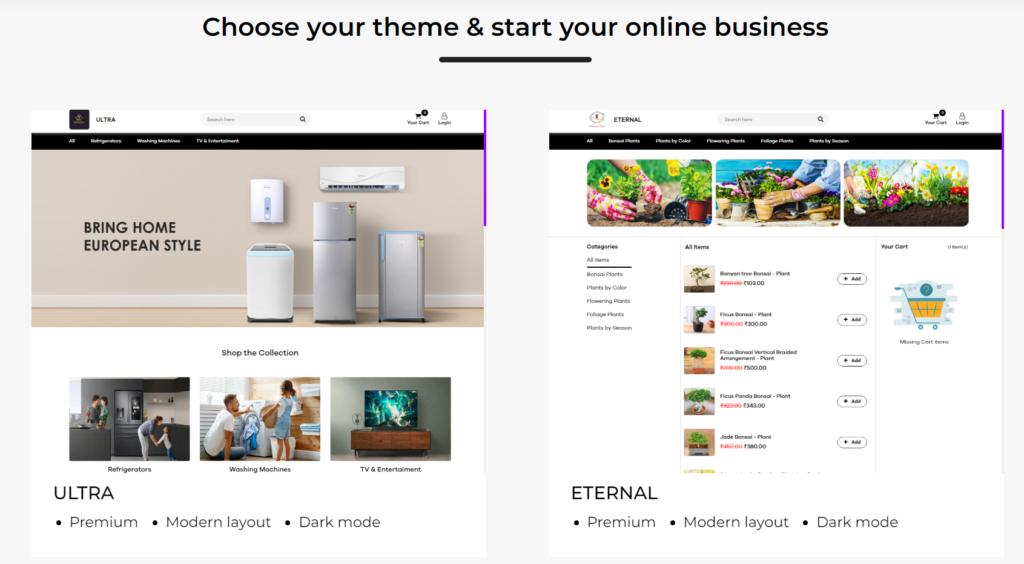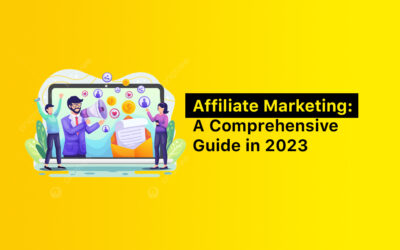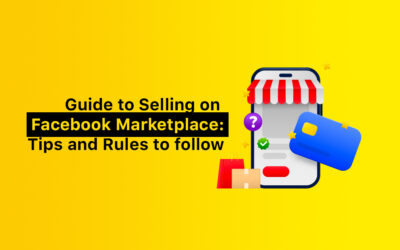In today’s digital age, having a website for your small business is essential. A website allows you to establish an online presence, reach a wider audience, and promote your products or services 24/7. But for small businesses with limited budgets, creating a website from scratch can seem like a daunting task. Fortunately, there are many free website creators or builders available online that make the process much easier. Here’s a guide to help you get started with Website design and creation for your small business.
Current trends and best Practices in Website design for Small businesses
Again, an SEO-friendly and integrations-equipped eCommerce website is a powerful tool that can help you reach a wider audience, increase brand awareness, and drive more traffic.
However, with so many websites on the internet, it is crucial to ensure that your website stands out from the competition. Below are some current trends and best practices in web design for small businesses:

1. Minimalistic design
Simple, and easy-to-navigate websites are gaining popularity among small businesses. The minimalistic design focuses on the essential elements of the website and eliminates any unnecessary clutter.
Choosing an ecommerce template which represents your business niche will make it accessible for search engines and users to find the information they need—without wasting any time.
2. Responsive design
With the majority of internet users accessing websites on their mobile devices, responsive design is crucial. Responsive design ensures that your website looks great and functions properly on any device, including desktops, tablets, and smartphones.
3. Personalization
Personalizing the user experience on your website can go a long way in establishing a connection with your audience. By using data-driven personalization techniques, small businesses can create a customized experience for their website visitors.
4. Interactive Elements
Incorporating interactive elements like animations, videos, and interactive graphics can help keep users engaged and improve the overall user experience.
Common Challenges faced by Small businesses in Website design
Below are some common challenges faced by small businesses in web design:
⦿ Lack of Resources
Small businesses often have limited resources, which makes it difficult to design and maintain a website.
⦿ Lack of technical Expertise
Most small business owners are not web design experts, which can lead to challenges in creating a website that is both functional and visually appealing.
⦿ Budget Constraints
Designing and maintaining a website can be expensive, and small businesses may not have the budget to hire a professional web designer.
⦿ Time Constraints
Small business owners wear many hats, and finding the time to design and maintain a website can be a challenge.
⦿ Finding the Right Design Agency
Small businesses may have difficulty finding a design agency that understands their unique needs and can provide high-quality website design services within their budget.
⦿ Mobile Responsiveness
With the rise of mobile devices, small businesses must ensure their website is optimized for mobile devices. However, they may not have the resources or expertise to create a responsive website that looks and functions well on various devices.
To summarize, small businesses often face many challenges when it comes to handle and run online operations, but by first finding the right agency to partner with, they can build a website that effectively communicates their brand and engages their audience.

Essential elements of a Small business website design
There are several essential elements that small business websites should have in order to be effective in attracting and engaging visitors. These elements include:
⟹ Clear and Interesting Homepage
The homepage should provide a clear and concise overview of what the business does, what it offers, and how it can help visitors. It should also include a call-to-action that encourages visitors to take the next step.
⟹ Easy Navigation
The website should be easy to navigate, with a clear and organized menu that makes it easy for visitors to find what they are looking for.
⟹ Contact Information
Small business websites should prominently display their contact information, including a phone number, email address, and physical address. This helps visitors to get in touch with the business if they have questions or need more information.
⟹ About Us Page
The About Us page should provide visitors with information about the business’s history, mission, and values. This can help to build trust and credibility with visitors.
⟹ Services/Products Page
The website should have a page that clearly outlines the services or products offered by the business. This can help visitors to understand what the business does and how it can help them.

Now that you know what are essential elements which a small business website should be equipped with, now it’s time to search for a website maker to help you build your website. Many platforms such as Wix, Shopify nowadays, allow users to build website (with drag and drop options too) and many provide a platform so you can hire a professional to get the job done.
Above mentioned both options seem to be time-consuming and expensive as well. Now this is where comes QPe. Talking of which, the emerging eCommerce platform QPe brings best affordable prices in industry for ecommerce website development with great ease.
Not only the platform allows users to create a website in minutes with pre-built themes and templates, it also brings in-built marketing tools and automation/integrations so you can have better visibility of users data and do the repeat business for a long term.
Key Considerations when Choosing a Web Hosting Provider
When it comes to creating a website, one of the most important decisions you’ll make is choosing a web hosting provider. Again, with so many options available, it can be overwhelming to decide which one to go with. Below, we’ll discuss the key considerations to keep in mind when choosing a web hosting provider:
► Uptime Guarantee
Uptime refers to the percentage of time that your website will be up and running. A good web hosting provider should offer an uptime guarantee of at least 99%.
This means that your website will be up and running 99% of the time. Anything less than 99% can result in downtime, which can negatively impact your website’s traffic and revenue.
► Customer Support
You want to choose a provider that offers 24/7 customer support so that you can get help whenever you need it. Look for providers that offer multiple ways to get in touch, such as phone, email, and live chat.
Additionally, read reviews from other customers to see how responsive and helpful the customer support team is.
► Security Measures
Here, make sure that the provider offers robust security measures, such as firewalls, malware scanning, and SSL certificates.
Furthermore, look for providers that offer regular backups, so that you can quickly recover your website design and backend in case of a security breach or data loss.
► Pricing
Pricing is always a consideration when making a purchase, and web hosting is no exception. However, it’s important to remember that the cheapest option may not always be the best.
Look for providers that offer transparent pricing and don’t hide fees or charge for unnecessary add-ons. In addition, consider the long-term costs, as some providers may offer lower introductory rates but increase the price after the first year.
► Server Location
The location of the server can also impact your website’s performance. Look for providers that offer servers in locations close to your target audience. This can help reduce latency and improve website speed for visitors in that location.
► Scalability Options
Finally, consider the scalability options offered by the provider. If you anticipate that your website will grow in the future, you want to choose a provider that can accommodate that growth.
You need to look for providers that offer easy upgrades, such as the ability to add more RAM or storage space, and can handle increased traffic without compromising website performance.
By considering these key factors when choosing a web hosting provider, you can ensure that you choose a reliable provider that meets your website’s needs. Remember to do your research and compare multiple providers to find the one that’s right for you.
PRO TIP: With an Ecommerce platform like QPe, you can put all your worries to rest. That being said, you can pick a customizable plan according to your business needs. In order to run your website on custom-domain, either you can pick a self-hosted plan or start your online store on QPe’s server. You don’t need break the bank and hire a professional to maintain your site or store, as you can do it all by your own. Nevertheless, QPe’s support team is always there to help you with every aspect.
Done creating your website? Now it’s time to optimize your website with SEO and On-page content to drive organic traffic which also helps with various aspects of marketing your business.
Tips for Optimizing SMBs website with SEO
Optimizing website for search engines is an important part of website development. Here are some tips to help you optimize your website design and content keeping search engine optimization in mind:
➔ Conduct Keyword Research
Research the keywords your target audience is using to search for the products or services you offer. Utilize tools like Google AdWords Keyword Planner, Ahrefs, or SEMrush to locate relevant keywords.
➔ Use Keywords Strategically
Once you’ve identified the relevant keywords, use them strategically in your content. Place them in the title, headings, subheadings, and throughout the body of your content. But avoid keyword stuffing, which can negatively impact your ranking.
➔ Write high-quality Content
Search engines prioritize high-quality content. Write content that is informative, engaging, and provides value to your audience. Use multimedia like images, videos, and infographics to enhance the user experience. Free product description generator tools can help you with the same.
➔ Optimize Your Images
Use descriptive file names and alt tags for your images. It improves website accessibility via search engine comprehension.
➔ Make Your Website mobile-friendly
With mobile devices accounting for a large percentage of internet traffic, it’s essential that your website is mobile-friendly. Use responsive design to ensure your website adapts to different screen sizes. You can opt to use Google’s free tools such as PageSpeed Web Dev etc.
➔ Improve Website Speed
Site speed is a crucial factor in SEO. Use tools like GTmetrix, PageSpeed Insights, or Pingdom to analyze your website speed and make necessary optimizations like compressing images, minifying CSS and JavaScript, and reducing HTTP requests.
➔ Build Quality backlinks
Backlinks from other high-authority websites signal to search engines that your website is valuable and trustworthy. Use strategies like guest posting, broken link building, or creating shareable content to earn quality backlinks.
By following these above mentioned tips, you can optimize your website design or content for search engines and improve your ranking in search results, driving more traffic and leads to your website.
Strategies for driving traffic to a Small business Website
There are several strategies that can be employed to drive traffic to a small/medium business website. So here are some effective ones:
Search Engine Optimization (SEO): Optimize your website for search engines by including relevant keywords, meta descriptions, and tags.
Content Marketing: Create high-quality content that is engaging and informative to attract visitors to your site. Share your content on social media platforms and other online forums to reach a wider audience.
Social Media Marketing: Leverage social media platforms like Facebook, Twitter, LinkedIn, and Instagram to promote your website and drive traffic to it. Learn more about social media marketing for eCommerce.
Email Marketing: Email marketing is essential for brand awareness. Build an email list and send regular newsletters and promotional emails to your subscribers to keep them engaged and informed about your website.
Paid Advertising: Invest in paid advertising, social media campaigns such as Google AdWords or Facebook Ads to drive traffic to your website.
Guest Blogging: Contribute guest posts to popular websites and blogs in your industry to gain exposure and drive traffic back to your website.
Referral Marketing: Offer incentives or rewards to customers or visitors who refer others to your website.

FINAL THOUGHTS
By considering the latest trends and best Practices in web design and development, you can manage and run your small businesses with your own selling platform. An e-commerce platform such as QPe can help you with every aspects of running an online business from essential elements of website design to marketing your brand.
In order to scale your ecommerce business, you can opt to many automation tools and integrations as well as POS software management.
Whether you run a food business online or have been selling goods; an Ecommerce platform such as QPe gives you freedom to choose your own delivery partner.
Moreover, you don’t need to worry about hosting plans or other aspects of building a website. QPe-powered websites are SEO-friendly and are designed to integrate with marketing tools and payments/delivery options.




